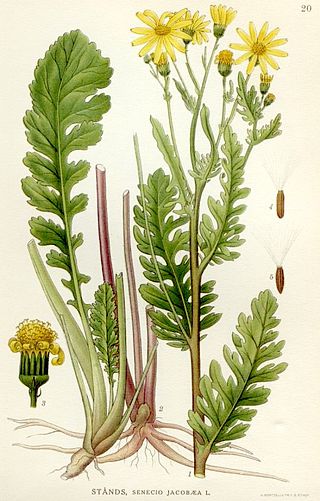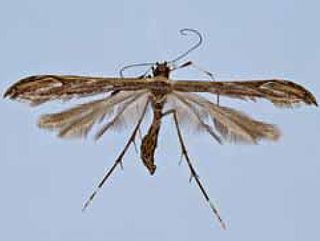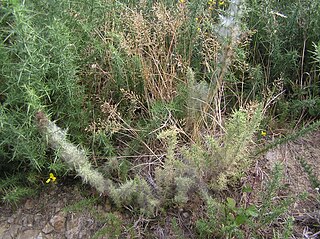
Jacobaea vulgaris, syn. Senecio jacobaea, is a very common wild flower in the family Asteraceae that is native to northern Eurasia, usually in dry, open places, and has also been widely distributed as a weed elsewhere.

Biological control or biocontrol is a method of controlling pests, such as insects, mites, weeds, and plant diseases, using other organisms. It relies on predation, parasitism, herbivory, or other natural mechanisms, but typically also involves an active human management role. It can be an important component of integrated pest management (IPM) programs.

Dipsacus is a genus of flowering plant in the family Caprifoliaceae. The members of this genus are known as teasel, teazel or teazle. The genus includes about 15 species of tall herbaceous biennial plants growing to 1–2.5 metres (3.3–8.2 ft) tall. Dipsacus species are native to Europe, Asia and northern Africa.

Lythrum salicaria or purple loosestrife is a flowering plant belonging to the family Lythraceae. It should not be confused with other plants sharing the name loosestrife that are members of the family Primulaceae. Other names include spiked loosestrife and purple Lythrum. This herbaceous perennial is native to Europe and Asia, and possibly Australia.

Alliaria petiolata, or garlic mustard, is a biennial flowering plant in the mustard family (Brassicaceae). It is native to Europe, western and central Asia, north-western Africa, Morocco, Iberia and the British Isles, north to northern Scandinavia, and east to northern Pakistan and Xinjiang in western China.

Pinus pinaster, the maritime pine or cluster pine, is a pine native to the south Atlantic Europe region and parts of the western Mediterranean. It is a hard, fast growing pine bearing small seeds with large wings.

Invasive species in Australia are a serious threat to the native biodiversity, and an ongoing cost to Australian agriculture. Numerous species arrived with European maritime exploration and colonisation of Australia and steadily since then.

Centaurea diffusa, also known as diffuse knapweed, white knapweed or tumble knapweed, is a member of the genus Centaurea in the family Asteraceae. This species is common throughout western North America but is not actually native to the North American continent, but to the eastern Mediterranean.

The winter moth is a moth of the family Geometridae. It is an abundant species of Europe and the Near East and a famous study organism for evaluating insect population dynamics. It is one of very few lepidopterans of temperate regions in which adults are active in late fall and early winter. The adults use endothermy for movement in these cold temperatures. The female of this species is virtually wingless and cannot fly, but the male is fully winged and flies strongly. After the initial frosts of late fall, the females emerge from their pupa, walk to and up trees, there emitting pheromones in the evening to attract males. Fertilized, she ascends to lay, on average, around 100 eggs. Typically, the larger the female moth is the more eggs she lays.

The oak processionary is a moth whose caterpillars can be found in oak forests, where they feed on oak leaves, causing significant damage. They travel in nose-to-tail processions, often arrow-headed, with a leader followed by rows of several caterpillars abreast. They are a human irritant because of their venomous setae, which can cause skin irritation and asthma. The species was first described by Carl Linnaeus in his 1758 10th edition of Systema Naturae.

Dipsacus fullonum, syn. Dipsacus sylvestris, is a species of flowering plant known by the common names wild teasel or fuller's teasel, although the latter name is usually applied to the cultivated variety D. fullonum var. sativus. It is native to Eurasia and North Africa, but it is known in the Americas, southern Africa, Australia and New Zealand as an introduced species.

Ageratina riparia, commonly known as mistflower, is a species of flowering plant in the family Asteraceae, native to Mexico. The species is widely adventive and has spread to Cuba, Jamaica, and other parts of the Caribbean. It has also been introduced as an ornamental plant and naturalized in a variety of regions, including parts of Hawaii, South Africa, Southeast Asia, Macaronesia, Oceania, Peru, and the Indian subcontinent. In tropical climates, A. riparia is highly invasive and a variety of control methods have been developed to reduce its spread.

The hemlock moth, also known as the defoliating hemlock moth or poison hemlock moth, is a nocturnal moth species of the family Depressariidae. Of Palaearctic origin, it was first found in North America in 1973 when it was accidentally introduced. The moth is now widespread throughout the northern half of the United States, southern Canada, northern Europe, and, more recently, New Zealand and Australia. The larval form grows to around 10 mm, while the adults wingspan is between 17 mm and 19 mm.

Hellinsia beneficus is a moth of the family Pterophoridae. It is native to Mexico, but was introduced to Hawaii in 1973 as a biological control agent against mistflower, Ageratina riparia.

Biological control programs for gorse in New Zealand have existed since the introduction of the gorse seed weevil in 1928. Biological pest control is the use of natural mechanisms such as predation to limit the growth and prevalence of a pest. The early research into the biological control of common gorse in New Zealand was among the first of such programs worldwide.

Dipsacus laciniatus is a species of flowering plant in the honeysuckle family known by the common name cutleaf teasel. It is native to Europe and Asia. It is present in North America as an introduced species and invasive weed.

Parapoynx stagnalis, the rice case bearer or rice caseworm, is a species of moth in the family Crambidae. It has a wide distribution and is found in India, Sri Lanka, South-East Asia, South Africa, South America, southern Europe, Russia and Australia.

In Australia, Mimosa pigra has been declared a noxious weed or given similar status under various weed or quarantine Acts. It has been ranked as the tenth most problematic weed and is listed on the Weeds of National Significance. It is currently restricted to the Northern Territory where it infests approximately 80,000 hectares of coastal floodplain.

Endothenia marginana, the downland marble, is a moth of the family Tortricidae. It was described by Adrian Hardy Haworth in 1811. It is found in almost all of Europe and across the Palearctic.

Abia sericea, common name club horned sawfly or scabious sawfly, is a species of sawflies belonging to the family Cimbicidae.



















